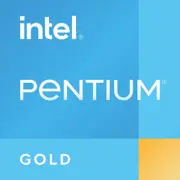Intel Pentium Gold 4410Y

Intel Pentium Gold 4410Y: A Compact Processor for Basic Tasks in 2025
April 2025
Architecture and Manufacturing Process: A Balance Between Efficiency and Modest Power
The Intel Pentium Gold 4410Y, released in 2017, belongs to the Kaby Lake generation and is still found in budget ultrabooks and compact devices. Its architecture is built on a 14nm manufacturing process, which appears archaic in 2025 compared to 5nm chips like Apple's M3 or Intel's Meteor Lake. However, it remains relevant for simple tasks due to its low power consumption.
- Cores and Threads: 2 cores, 4 threads (Hyper-Threading).
- Clock Speeds: Base — 1.5 GHz, no turbo mode.
- Graphics: Intel HD Graphics 615 with a base frequency of 300 MHz and a maximum of 850 MHz.
Architecture features:
- Supports DDR3L/LPDDR3 and DDR4 RAM (up to 16 GB).
- The integrated graphics chip handles 4K video decoding (H.265/VP9), useful for streaming.
- Lack of Turbo Boost — the processor runs at a fixed frequency, limiting performance but simplifying thermal management.
Power Consumption and TDP: Ideal for Passive Cooling
The 6W TDP is a key feature of the Pentium 4410Y. This allows it to be used in fanless devices, making laptops completely silent. For example, the Chuwi Minibook line or some Lenovo Yoga models.
Practical Outcomes of Low TDP:
- Minimal Heating: Even under full load, the temperature rarely exceeds 60°C.
- Compact Cooling Systems: Space savings in the chassis for the battery or other components.
Performance: What Can You Do with the Pentium Gold 4410Y in 2025?
Office Tasks
- Task Examples: Working in Google Docs, Excel with spreadsheets up to 10,000 rows, Zoom conferences.
- Benchmark Results: In PCMark 10 (Office Suite), the processor scores about 1800–2000 points. This is sufficient for basic multitasking, but opening 20+ tabs in Chrome simultaneously will cause lag.
Multimedia
- 4K/60 FPS Video: Playback through VLC or YouTube without lag due to hardware decoding.
- Photo Editing: Editors like Canva or Lightroom (basic edits) work, but exporting photos takes 2–3 times longer than on a Core i3 of the 12th generation.
Gaming
- Integrated HD 615 Graphics:
- CS:GO: 720p, low settings — 25–35 FPS.
- Minecraft: 30 FPS on medium settings.
- Modern Games (2023–2025): Only cloud gaming (GeForce NOW, Xbox Cloud).
Usage Scenarios: Who Would Benefit from This Processor?
- Students: For studying (essays, presentations), watching lectures.
- Office Workers: Working with documents, email, CRM systems.
- Digital Minimalism Users: Those who value silence and long battery life.
Not Suitable For:
- Video editors, 3D designers.
- Gamers (other than casual games like Among Us).
Battery Life: How Does the Processor Affect Operating Time?
Average battery life for laptops with the Pentium 4410Y is 8–12 hours (with a battery capacity of 40–50 Wh).
Power-Saving Technologies:
- Intel SpeedStep: Dynamic frequency management.
- Panel Self Refresh: Reduces GPU load with static images.
- Windows 11's "Power Saving" Mode: Automatically limits background processes.
Tip: For maximum battery life, choose models with IPS screens with a brightness of 250 nits and a resolution no higher than Full HD.
Comparison with Competitors: What to Choose Instead of Pentium 4410Y?
AMD Athlon Silver 7120U (2023)
- Pros: 2 cores/2 threads, 15W TDP, Radeon 610M graphics (20% faster than HD 615).
- Cons: Higher price (laptops from $450).
Apple M1 (2020)
- Pros: Huge performance increase (3–4 times), 18 hours of battery life.
- Cons: Price — MacBook Air M1 starts at $799.
Intel N100 (2023)
- Pros: 4 cores, UHD graphics (24 EU), AV1 support.
- Cons: 6W TDP, laptops starting at $350.
Conclusion: The Pentium 4410Y lags behind modern counterparts but excels in price (devices from $300).
Pros and Cons of the Processor
Strengths:
- Low-cost laptops.
- Passive cooling — no noise.
- Support for 4K video.
Weaknesses:
- Low performance in multitasking.
- Outdated manufacturing process (14nm).
- No support for Wi-Fi 6 or Thunderbolt 4.
Recommendations for Choosing a Laptop
- Device Type: Ultrabooks (Acer Swift 1), convertibles (HP Pavilion x360).
- What to Check:
- RAM: Minimum 8 GB (better 16 GB for Windows 11).
- Storage: Only SSD (256 GB and above).
- Screen: Matte finish, Full HD resolution.
2025 Model Examples:
- Lenovo IdeaPad Slim 3: $349, 8 GB RAM, 256 GB SSD.
- ASUS VivoBook Go 14: $399, touchscreen.
Final Conclusion: Who is the Pentium Gold 4410Y Suitable For?
This processor is ideal for those who are looking for a cheap laptop for internet use, studying, or text processing.
- Values silence and long battery life.
- Does not plan to run “heavy” applications.
Key Benefits:
- Device prices starting at $300.
- Ability to work all day without recharging.
- Compactness and weight of less than 1.5 kg.
Alternative: If your budget allows for $400–500, it is better to choose a laptop with the Intel N100 or AMD Ryzen 3 7320U — they will last longer and not disappoint in performance.
The Pentium Gold 4410Y in 2025 is a prime example of a “workhorse” for undemanding tasks. It may not impress with speed but will be a reliable helper in a budget-sensitive environment.
Basic
CPU Specifications
Memory Specifications
GPU Specifications
Miscellaneous
Share in social media
Or Link To Us
<a href="https://cputronic.com/en/cpu/intel-pentium-gold-4410y" target="_blank">Intel Pentium Gold 4410Y</a>